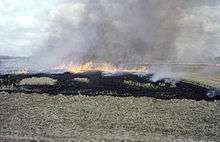Stubble burning

Stubble burning is the deliberate setting fire of the straw stubble that remains after wheat and other grains have been harvested. The practice was widespread until the 1990s, when governments increasingly restricted its use.
Effects
.jpg)
The burning of stubble, contrasted with alternatives such as ploughing the stubble back into the ground has a number of consequences and effects on the environment[1]
Stubble burning:
- Quickly clears the field and is cheap.
- Kills weeds, including those resistant to herbicide.
- Kills slugs and other pests.
- Can reduce nitrogen tie-up
However, it has a number of harmful effects on the environment:
- Loss of nutrients.
- Pollution from smoke.
- Damage to electrical and electronic equipment from floating threads of conducting waste.
- Risk of fires spreading out of control[2]
There is a perception that stubble burning contributes to atmospheric CO2. However carbon dioxide releases are only slightly greater than those from natural decomposition[1]
Attitudes to stubble burning
- Stubble burning has been effectively prohibited since 1993 in England and Wales.[3] A perceived increase in blackgrass, and particularly herbicide resistant blackgrass, has led to a campaign by some arable farmers for its return.[4]
- In Australia stubble burning is "not the preferred option for the majority of farmers"[1] but is permitted and recommended in some circumstances. Farmers are advised to rake and burn windrows, and leave a fire break of 3 metres around any burn off.[2]
- In the United States, fires are fairly common in mid-western states. Many of the fires in the video are started deliberately.
- In France, stubble burning is said to be fairly common.
- In China, there is a governmental ban on stubble burning, however the practice remains fairly common.[5]
- In northern India, despite a ban by the Punjab Pollution Control Board, the practice of stubble burning is still practiced. Authorities are starting to enforce this ban more proactively.[6]
- Stubble burning is allowed by permit in some Canadian provinces, including Manitoba where 5% of farmers were estimated to do it in 2007.[7]
Stubble burning in India
Stubble burning in Punjab and Haryana in northwest India has been cited as a major cause of air pollution in Delhi.[8] From late September through October of each year, farmers mainly from Punjab and Haryana burn an estimated 35 million tons[9] of crop waste from their wheat fields after harvesting, as a low-cost straw-disposal practice to reduce the turnaround time between harvesting and sowing for the second (winter) crop.[10] Smoke from this burning produces a cloud of particulates visible in images from space,[11] and has produced a "toxic cloud" in New Delhi, resulting in declarations of an air-pollution emergency.[12] For this, NGT (National Green Tribunal) slapped a fine of Rs. 2 lakh on the Delhi Government for not filing an action plan providing incentives and infrastructural assistance to farmers to stop them from burning crop residue to prevent air pollution.[13]
Although harvesters are available such as the Indian-manufactured "Happy Seeder" that shred the crop residues into small pieces and uniformly spread them across the field, as an alternative to burning the crops, farmers complain that the cost of these machines is prohibitive compared to burning the fields.[10]
See also
References
- 1 2 3 "Grains and Other Crops» Crop Production» Stubble Burning".
- 1 2 Ellison, Amelia (August 24, 2013). "Stubble burns cause headache for firebrigades". The Wimmera Mail Times. Retrieved 24 August 2013.
- ↑ "The Crop Residues (Burning) Regulations 1993". www.legislation.gov.uk.
- ↑ Tasker, Johann (May 30, 2012). "Farmers step up stubble burning campaign". Retrieved 24 August 2013.
- ↑ "Farmers burn wheat stubble despite ban". Peoples Daily. June 15, 2013. Retrieved 24 August 2013.
- ↑ "Paddy stubble burning: Two farmers booked in Sangrur". Hindustan Times. October 31, 2014. Retrieved 23 November 2014.
- ↑ "Smoke from stubble fires engulfs Winnipeg". Canadian Broadcasting Corporation. September 6, 2007.
- ↑ Geeta Anand, "Farmers’ Unchecked Crop Burning Fuels India’s Air Pollution", The New York Times, Nov. 2, 2016. Retrieved 9 November 2017.
- ↑ Joydeep Thakur, Brace for air pollution in Delhi as crop burning starts in neighbouring states: Agricultural stubble running into millions of tonnes is burnt by farmers in northern India every October. An estimated 35 million tonnes are set afire in Punjab and Haryana alone. Hindustan Times, Sep 28, 2017. Retrieved 9 November 2017.
- 1 2 Sowmiya Ashok, "Agricultural pollution: The fields are still burning", The Indian Express, October 19, 2017. Retrieved 9 November 2017.
- ↑ NASA, "Stubble Burning in Northern India", Earth Observatory. Retrieved 9 November 2017.
- ↑ Sanjeev Miglani and Aditya Kalra, "New Delhi declares emergency as toxic smog thickens by the hour", Reuters, Nov. 9, 2017. Retrieved 9 November 2017.
- ↑ "Crop burning: NGT slaps Rs 2 lakh as costs on Delhi govt for not filing action plan". https://www.hindustantimes.com/. 2018-04-03. Retrieved 2018-06-26. External link in
|work=(help)